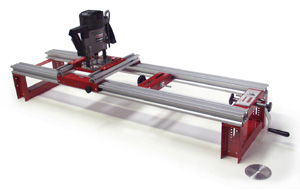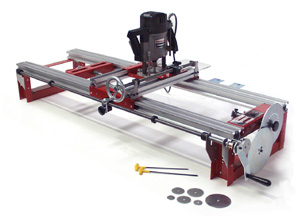
Four exactly matched and turned legs. Fluting. Barley twists. Wainscoting. Cabriole legs. Four-, six- or eight-sided newel posts. Rosettes. Crown molding. Picture frames. Escutcheons. Four-poster canopy beds. What do these virtuoso pieces of woodworking have in common? They can all be created with your plunge router and the Legacy Ornamental Mill system. At first glance, you can see that a router is mounted on a couple of tracks, and there’s some kind of crank at one end & but how it could produce this extraordinary range of woodwork is a bit of a puzzler.
Knowing that the system involved indexing and X-Y-Z axis milling might provide an inkling of the process, but to paraphrase a line from the movie, “The Matrix,” the Legacy system is not easy to explain — but must be experienced. Fortunately, the company will send you a DVD demonstrating the Legacy in action. And you will be amazed.
What we can explain is how the system came about in the first place. The groundwork for the business started while company founder Andy Anderson was growing up in Utah. Among other vocations, his grandfather was a cabinetmaker and got Andy, and his brother, Tracey, started. And Andy’s father made sure the boys had access to all kinds of tools while they was growing up. Flash forward to the late 1980s, and Andy was designing tooling for companies like IBM and living in the San Francisco Bay area.
“I had a partner, and we were basically manufacturing things like robotic systems for the semi-conductor industry.” Andy recalled, “I had a nice income, but woodworking was my passion, and I had enough money to start buying better tools.”
He bought a nice saw and the usual tools as he built up his shop, but what he was really looking for were tools that would help build the Victorian-style furniture he and his wife liked so much.
“I bought a lathe and looked at copy attachments, but you’re limited to mostly round designs and that only takes you so far down the road.” Andy explained, “Most Victorian designs have a lot of geometric fluting, and they might have a six-sided element in the middle of a turned leg. I read that you could make tapered legs on a table saw, but really you can only make tapered Shaker-style legs. I kept running into roadblocks trying to get from here to there. It seemed the only option was laying out the shape and then hand carving it. I got a little frustrated.”
According to Andy, furniture making in the 19th century was labor-intensive. Band saws might be used to cut out layouts and shapes, but there was a great deal of hand scraping, carving, and planing. And there just weren’t enough hours in his day for him to take that approach.
“Things like the six-sided newel post on the staircase in Hitchcock’s movie Psycho always fascinated me, and I’ve always wanted to build a masterpiece,” Andy noted. “So I asked myself ‘How am I going to build it?’ There are not many 18th or 19th century craftsmen around to teach me, so I started looking for a modern approach.”
In his quest, Andy went to the IWF show in Atlanta in the late 1980s. The only thing that came close to what he needed was a huge Hapfo lathe. Made in Germany, it was mounted on a giant shaper and cost around $65,000 & too large for his garage and too expensive for his budget.
“That’s the point where I got stalled.” Andy explained, “I was complaining to a friend who chided me and pointed out that if I could build equipment for the semi-conductor business, surely I ought to be able to design something for woodworking.”
Working with his brother, he started experimenting with different fixtures and tools. The first prototypes were plywood and didn’t deliver the accuracy or precision they wanted, but they knew they were headed down the right road. The first successful machine, built in 1989, was an indexing system that would do tapering. A router could run back and forth on a track over the stock that was indexed at an angle to create four-, six-, or eight-sided pieces.
“It was really pretty one-dimensional,” Andy recalled, “Then we started playing around with rotating the piece into different router bit shapes. We could put together a few screws and gears and create spirals and went from indexing and milling to turning and then to cutting spirals, creating spindles, and making joints. Along the way, we made the frame wider and created a three-axis track for the router. Now you put a piece of flat wood in there and make fancy crown moldings with little rosettes and fun things like that.”
According to Andy, to build a piece of fine furniture with good-looking legs, every novice has to learn how to turn. Yet turning four identical legs without a copy attachment is one of the biggest challenges facing any woodworker. The Legacy system provides an easier way to turn and get repeatable results.
“It allows you to be creative but still have a lot of serious control in a very safe and easy to operate environment, which is always nice in today’s world. All cutting happens below the router base inside of the frame, so your hands are far away from anything remotely dangerous. Yet you have the ability to create and mix and match round turning with geometric elements.”

In 1991, around the time that Andy decided to relocate his business and home to Provo, Utah, they started using aluminum in the machines. As Andy explained, “we quit making goof-around toys and started building a better, more accurate tool.” The first model was called the “Woodchuck system” and turned out to be just what woodworkers wanted.
“Toward the end of the 1980s people had grown tired of that decade’s characteristically rounded edges and wanted something a little more formal,” he noted. “They were taking pictures of old furniture and asking custom furniture builders if they could build something like that. And as I made the rounds to woodworking shows, my conversations with professional cabinetmakers and furniture builders convinced me to build a bigger machine. From 1993 to 1997 we focused on the professional market.”
In 1997 the company introduced the Legacy Series, which could do everything previous models could do, plus create decorative molding. Still working closely with professional cabinetmakers, the company began to more actively court the hobbyist market. Up until 1999, Andy made every machine and part himself. The Legacy web site also went online that same year.
The fifth generation of Legacy systems, using all extruded aluminum, was just introduced in November 2003.
“We have always had an association with the amateur woodworker who is just doing this for fun and pleasure.” Andy detailed, “As the Legacy evolved, we learned how to put its capabilities into a smaller, less expensive machine. For a quarter of the price, our new 900 model has the same capabilities as the $4,000 machine we were selling to professional furniture builders in 1995.”
When they started out, each machine would be customized to the buyer’s needs. Now numerous accessories are available, and each model is a complete woodworking system. The only difference between the 400 and 900 model is that the 400 does not have the spiraling capability, making it ideal for woodworkers who prefer Shaker and Arts and Crafts styles. Yet by simply rotating the stock, the 400 can create the cabriole legs characteristic of Queen Anne-style furniture.
What’s ahead for Legacy?
“One of the things that I’m working on is a bowl-turning system, which will still use a router to do the cutting, but will let us combine the geometric control with the turning process.” Andy added, “And we’ll be able to turn a bowl and create some sweeping flutes around the contour!”







